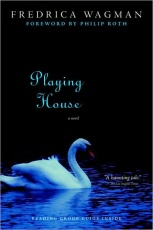 Publisher's Summary. When Playing House appeared in 1973, Publishers Weekly hailed it, "A probing descent into madness that will fascinate the same audience that appreciated I Never Promised You a Rose Garden." This nationally bestselling story of one woman’s struggle with the lasting effects of a childhood sexual relationship with her brother shocked American readers; it remains a literary work of enduring quality and value. In his foreword Philip Roth writes, "The traumatized child; the institutionalized wife; the haunting desire; the ghastly business of getting through the day -- what is striking about Wagman's treatment of these contemporary motifs is the voice of longing in which the heroine shamelessly confesses to the incestuous need that is at once her undoing and her only hope."
Publisher's Summary. When Playing House appeared in 1973, Publishers Weekly hailed it, "A probing descent into madness that will fascinate the same audience that appreciated I Never Promised You a Rose Garden." This nationally bestselling story of one woman’s struggle with the lasting effects of a childhood sexual relationship with her brother shocked American readers; it remains a literary work of enduring quality and value. In his foreword Philip Roth writes, "The traumatized child; the institutionalized wife; the haunting desire; the ghastly business of getting through the day -- what is striking about Wagman's treatment of these contemporary motifs is the voice of longing in which the heroine shamelessly confesses to the incestuous need that is at once her undoing and her only hope." Review. My English Literature 101 professor once explained that “happy ending” novels rarely qualify as literature because after the story’s conclusion there is little to discuss. Think about it for a moment. Would readers still ponder Gone with the Wind if Scarlett had bagged her man? Would To Kill a Mockingbird be as powerful if Boo Radley had received a fair trial? Would The Great Gatsby be a “Great American Novel” if Gatsby had spent his golden years with Daisy? With some exceptions I believe my professor’s point was well taken.
By this measure, Playing House by Frederica Wagman is great literature. When I finished this novel I was dying to talk about it with someone: the symbolism; the characters; the repetitious writing style; and the subject matter. Playing House’s subject matter – sibling incest – shatters cultural taboos and is not for readers with certain sensibilities. The unnamed narrator is both a victim and a willing participant in the incestuous relationship that thrived in her dysfunctional family unit. As she admits, “I never had a brother, I had a lover. I never knew what the word ‘brother’ could mean, what the word ‘sister’ could mean, what the word ‘mother’ could mean – it was all meaningless to me, all except what it felt like being with him, that was the only meaning.”
On a stylistic level Playing House is highly symbolic: the Swan that the narrator clings to; the color yellow which is used to describe everything from light, to grass, to hair, and dress; and the smoke that destroys the narrator’s sister and threatens to claim the narrator. A typical illustrative passage is this one: “A yellow-white aloneness hung around the glass birds and the dancing swans in crystal cages behind the gilt lattice doors, there was no conversation except my mother talking to herself about how no one was good enough for us except each other, her poison, her inbred murder, her disaster, while she grinned and posed and wet her lips and saw herself reflected, poor soul, poor little mother, poor wreck in a yellow satin dressing gown with threadbare cuffs and elbows, with yellow eyes that didn’t see, that could only stop where the noise was coming from.” For an excellent review of many of the themes/symbols in Playing House I highly recommend Shellie of Layers of Thought’s review.
Playing House is the perfect novel for thoughtful discussions!




I love the way you explored color and symbolism in your review. I'm not sure whether this book is for me, but I enjoyed reading what you had to say.
ReplyDeleteKim/DC -
ReplyDeleteVery nice and thoughtful review and thanks for including mine in yours with such a nice compliment. Have a wonderful weekend. I should have that interview posted some time next week.
Shellie
Thanks for sharing that tidbit from your professor. I'd never thought of it before, but I think she might be right. You've made me very curious about this book, and I'd like to read it now.
ReplyDelete